|
Caledon Citizen https://caledoncitizen.com/celebration-of-40-years-of-heritage-in-caledon-has-started/ Export date: Mon Apr 21 3:38:59 2025 / +0000 GMT |
Celebration of 40 years of heritage in Caledon has startedBy Bill Rea Students from Ellwood Memorial Public School and others got to learn some facts about caledon history recently, and in an amusing way. They were on hand at the Albion-Bolton branch of Caledon Public Library for a Caledon Heritage Fair. It was part of the celebrations to mark 40 years of Heritage Caledon working to preserve the history of the area. “It's a very busy and exciting morning,” Mary Maw, manager of communications and community development for the library told those assembled. Mayor Allan Thompson was on hand as well, telling people history is all about culture, and learning from the mistakes that have been made in the past. He called the 40 years that Heritage Caledon has been on the job “really special.” He also had some fun with the kids, getting them to guess how many heritage buildings and structures have been preserved in Caledon (118 was the correct answer). He added the Heritage Fair was the way they were kicking off the year of celebrating. “We're going to keep the heritage committee really busy this year,” he said. “A lot of us have deep roots here, and it's very special.” Caledon's Heritage Resource Officer Sally Drummond also stressed the need for preserving heritage. Saving things that have survived from the past enables people today to determine where they have come from, she said. Caledon is a large place with a lot of geography, she pointed out. The are two large rivers in the area, as well as other features that would have influenced First Nation people and other settlers to make use of it. Drummond showed a number of items from the past, such as large oak pegs that would have been used to hold the components of log cabins together. She also showed a mould for ballons that were made at Alton Mill when it was a rubber factory. For a time, those balloons were sold to Disney Studios. There were a number of stories that were shared at the Fair. Helen Mason told the story of two families from Scotland, and how they came to be connected to a house in Caledon. She also said the word “caledon” is from a latin word meaning Scotland. There was a family named Smith that came here from the area of Inverness in Scotland about 150 years ago. It was a hard place to live at the time, but there was plenty of material from which to build houses. People were able to get land from the government, but there was a lot of work expected of them, including cutting down trees, building a house and creating roads. The first Smith house was a log one. The family grew, and in time the minister of Claude Presbyterian Church was living with them. The farm also expanded to include barns and a red brick farmhouse. The Smiths also contributed to the building of the Claude Church. They built it to look similar to the church in the town in Scotland they had come from. “They built the church to remind them of the church they attended when they were children,” Mason observed. She added that her's is the second family, which came from a village near Inverness about 50 years ago. She and her husband settled in Toronto, but the Smith farm went up for sale. “We fell in love,” she said. “We wanted that place. Life was much easier 50 years ago than it was 150 years ago. We already had a house.” Mason said her children loved playing in the barn, replaced some of the forest and continued to look after the house. All three of them had their wedding receptions in the barn, but none of them were interested in farming full-time. She said they built an apartment at the rear of the house and rented it out. The first tennant was the minister at Claude Church. “That circle is complete,” she observed. Mason said a developer had been dismantling a house nearby and found an almost complete log house inside. With the help of Heritage Caledon and friends, Mason said they were able to move the house “very slowly” to the Mason property. She said her granddaughter was playing archeologist near the house, and found pieces of broken china, as well as old nails and shingles. They found they had put the building at the site of the original log cabin. “That's another circle complete after 150 years,” she remarked. Local scholar John Steckley offered the students some facts about the history of the area that he said they're not likely to read in history books. He said humans have been around Caledon for about 11,000 years. After the glaciers retreated, he said they left things like the Oak Ridges Moraine, which he likened to a “big pile of glacier poo.” There were caribou around here, as well as mastodons (he said he's seen teeth from such creatures). Fish were an important part of the diet of people living here. Steckley said about 4,000 years ago, water flowed fast between Lakes Couchiching and Simcoe. Some people erected poles and put up barriers to keep the fish in one area. The Mohawks called it “tkaronto,” meaning poles in water, and he said that's how Toronto got its name. The Hurons got their name from the French, and Steckley said it was something of an insult because it referred to way they wore their hair. Their real name was Wendat. He said their territory went south to a lake they called Ontario, which he said means “It's a large lake.” “Most people in Ontario don't know what ‘Ontario' means,” he told the students. “You do.” 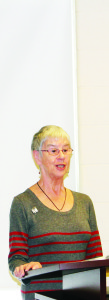 Helen Mason had some stories about early settlement in Caledon. 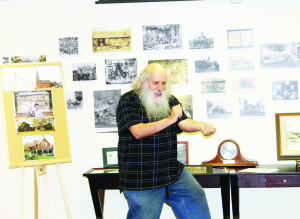 John Steckley put on a very animated presentation about the aboriginal history of Caledon. 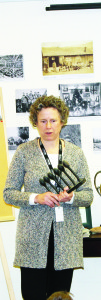 Caledon's Heritage Resource Officer Sally Drummond was holding up this mould that was used for making balloons. 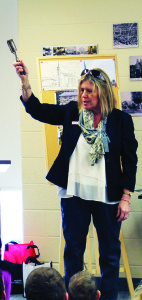 Students at the recent Caledon Heritage Fair had a bit of trouble guessing what this artifact was that Mary Maw, manager of communications and community development for Caledon Public Library, was holding up. It was a curling iron. 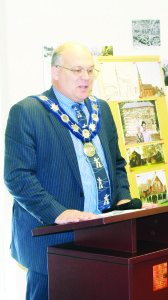 Mayor Allan Thompson was on hand, stressing the importance of heritage conservation. |
|
Post date: 2016-03-09 18:00:54 Post date GMT: 2016-03-09 23:00:54 Post modified date: 2016-03-10 14:35:36 Post modified date GMT: 2016-03-10 19:35:36 |
|
Export date: Mon Apr 21 3:38:59 2025 / +0000 GMT This page was exported from Caledon Citizen [ https://caledoncitizen.com ] Export of Post and Page has been powered by [ Universal Post Manager ] plugin from www.ProfProjects.com |